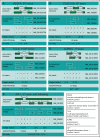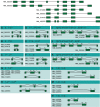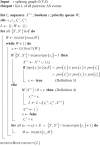A general definition and nomenclature for alternative splicing events
- PMID: 18688268
- PMCID: PMC2467475
- DOI: 10.1371/journal.pcbi.1000147
A general definition and nomenclature for alternative splicing events
Abstract
Understanding the molecular mechanisms responsible for the regulation of the transcriptome present in eukaryotic cells is one of the most challenging tasks in the postgenomic era. In this regard, alternative splicing (AS) is a key phenomenon contributing to the production of different mature transcripts from the same primary RNA sequence. As a plethora of different transcript forms is available in databases, a first step to uncover the biology that drives AS is to identify the different types of reflected splicing variation. In this work, we present a general definition of the AS event along with a notation system that involves the relative positions of the splice sites. This nomenclature univocally and dynamically assigns a specific "AS code" to every possible pattern of splicing variation. On the basis of this definition and the corresponding codes, we have developed a computational tool (AStalavista) that automatically characterizes the complete landscape of AS events in a given transcript annotation of a genome, thus providing a platform to investigate the transcriptome diversity across genes, chromosomes, and species. Our analysis reveals that a substantial part--in human more than a quarter-of the observed splicing variations are ignored in common classification pipelines. We have used AStalavista to investigate and to compare the AS landscape of different reference annotation sets in human and in other metazoan species and found that proportions of AS events change substantially depending on the annotation protocol, species-specific attributes, and coding constraints acting on the transcripts. The AStalavista system therefore provides a general framework to conduct specific studies investigating the occurrence, impact, and regulation of AS.
Conflict of interest statement
The authors have declared that no competing interests exist.
Figures

 are numbered consecutively from 5′ to 3′. Subsequently, the splicing structure is described with the Malko's 5-component strings, Nagasaki's bit matrices and integer vectors, the nomenclature of the ASD/ATD/AEdb databases and with the AS code we propose in this work. The nomenclature of ASD/ATD/AEdb assigns ambiguously the same identifier to the structures in VEGFA (A) and TCL6 (C), respectively in CLEC10A (B) and AURKC (D). In CLEC10A (B), the bit matrix system assumes independence between both sides of the exon and therefore can not identify a single AS event. In AURKC (D), the vector (1,3) is assignable from the bit matrices, but it is not considered as part of the alternative donor event (9,13). Authors of the ASD/ATD/AEdb nomenclature propose the term “CIR” for complex intron retention structures. However, as in AIF1 (E), the selection of the central intron can be problematic as the names “CIR-II-5p3p-5p-IR-3p”, “CIR-CIR-II5p3p-5p-5p”, or “CIR-II5p4p-CIR-IR-3p-3p” could be imaginable.
are numbered consecutively from 5′ to 3′. Subsequently, the splicing structure is described with the Malko's 5-component strings, Nagasaki's bit matrices and integer vectors, the nomenclature of the ASD/ATD/AEdb databases and with the AS code we propose in this work. The nomenclature of ASD/ATD/AEdb assigns ambiguously the same identifier to the structures in VEGFA (A) and TCL6 (C), respectively in CLEC10A (B) and AURKC (D). In CLEC10A (B), the bit matrix system assumes independence between both sides of the exon and therefore can not identify a single AS event. In AURKC (D), the vector (1,3) is assignable from the bit matrices, but it is not considered as part of the alternative donor event (9,13). Authors of the ASD/ATD/AEdb nomenclature propose the term “CIR” for complex intron retention structures. However, as in AIF1 (E), the selection of the central intron can be problematic as the names “CIR-II-5p3p-5p-IR-3p”, “CIR-CIR-II5p3p-5p-5p”, or “CIR-II5p4p-CIR-IR-3p-3p” could be imaginable.
 numbered from 5′ to 3′ are presented. Besides traditional events as skipped exon (A and G), retained intron (B), mutually exclusive exons (H), alternative donor (C) and acceptor site (F), novel events are observed that involve more than one of the latter types (D and E) or are connected to differences in the transcription start/polyadenylation site (I through N). Note that in our method L, M and N are considered as three different events that expose the same structure (i.e., –,–[4]).
numbered from 5′ to 3′ are presented. Besides traditional events as skipped exon (A and G), retained intron (B), mutually exclusive exons (H), alternative donor (C) and acceptor site (F), novel events are observed that involve more than one of the latter types (D and E) or are connected to differences in the transcription start/polyadenylation site (I through N). Note that in our method L, M and N are considered as three different events that expose the same structure (i.e., –,–[4]).





 that are described by transcript pairs (St,Su) in a locus C. By priority queue W, nodes si of the splicing graph are iterated from 5′ to 3′ according to pos(si). The queue contains at the beginning root and subsequently is filled with all nodes sj that are connected by outedges of si —if they are supported by either St or Su.
that are described by transcript pairs (St,Su) in a locus C. By priority queue W, nodes si of the splicing graph are iterated from 5′ to 3′ according to pos(si). The queue contains at the beginning root and subsequently is filled with all nodes sj that are connected by outedges of si —if they are supported by either St or Su.Similar articles
-
ASTALAVISTA: dynamic and flexible analysis of alternative splicing events in custom gene datasets.Nucleic Acids Res. 2007 Jul;35(Web Server issue):W297-9. doi: 10.1093/nar/gkm311. Epub 2007 May 7. Nucleic Acids Res. 2007. PMID: 17485470 Free PMC article.
-
Exon Nomenclature And Classification of Transcripts (ENACT) provides a systematic framework to annotate exon attributes.Genome Res. 2025 Jun 2;35(6):1440-1455. doi: 10.1101/gr.279878.124. Genome Res. 2025. PMID: 40335152
-
Analysis of alternative splicing events in custom gene datasets by AStalavista.Methods Mol Biol. 2015;1269:379-92. doi: 10.1007/978-1-4939-2291-8_24. Methods Mol Biol. 2015. PMID: 25577392
-
Gene and alternative splicing annotation with AIR.Genome Res. 2005 Jan;15(1):54-66. doi: 10.1101/gr.2889405. Genome Res. 2005. PMID: 15632090 Free PMC article.
-
Read-Split-Run: an improved bioinformatics pipeline for identification of genome-wide non-canonical spliced regions using RNA-Seq data.BMC Genomics. 2016 Aug 22;17 Suppl 7(Suppl 7):503. doi: 10.1186/s12864-016-2896-7. BMC Genomics. 2016. PMID: 27556805 Free PMC article.
Cited by
-
Comparative Transcriptomics of Rice Genotypes with Contrasting Responses to Nitrogen Stress Reveals Genes Influencing Nitrogen Uptake through the Regulation of Root Architecture.Int J Mol Sci. 2020 Aug 11;21(16):5759. doi: 10.3390/ijms21165759. Int J Mol Sci. 2020. PMID: 32796695 Free PMC article.
-
Differences in Alternative Splicing between Yellow and Black-Seeded Rapeseed.Plants (Basel). 2020 Jul 31;9(8):977. doi: 10.3390/plants9080977. Plants (Basel). 2020. PMID: 32752101 Free PMC article.
-
Exploring the functional impact of alternative splicing on human protein isoforms using available annotation sources.Brief Bioinform. 2019 Sep 27;20(5):1754-1768. doi: 10.1093/bib/bby047. Brief Bioinform. 2019. PMID: 29931155 Free PMC article. Review.
-
Transcriptome profile at different physiological stages reveals potential mode for curly fleece in Chinese tan sheep.PLoS One. 2013 Aug 26;8(8):e71763. doi: 10.1371/journal.pone.0071763. eCollection 2013. PLoS One. 2013. PMID: 23990983 Free PMC article.
-
Whole-transcriptome splicing profiling of E7.5 mouse primary germ layers reveals frequent alternative promoter usage during mouse early embryogenesis.Biol Open. 2018 Mar 28;7(3):bio032508. doi: 10.1242/bio.032508. Biol Open. 2018. PMID: 29592913 Free PMC article.
References
-
- Black DL. Mechanisms of alternative pre-messenger RNA splicing. Annu Rev Biochem. 2003;72:291–336. - PubMed
-
- Lopez AJ. Alternative splicing of pre-mRNA: developmental consequences and mechanisms of regulation. Annu Rev Genet. 1998;32:279–305. - PubMed
-
- Smith CW, Valcarcel J. Alternative pre-mRNA splicing: the logic of combinatorial control. Trends Biochem Sci. 2000;25:381–388. - PubMed
-
- Lander ES, Linton LM, Birren B, Nusbaum C, Zody MC, et al. Initial sequencing and analysis of the human genome. Nature. 2001;409:860–921. - PubMed
-
- Florea L. Bioinformatics of alternative splicing and its regulation. Brief Bioinform. 2006;7:55–69. - PubMed
Publication types
MeSH terms
Substances
LinkOut - more resources
Full Text Sources
Other Literature Sources
Molecular Biology Databases
Research Materials

